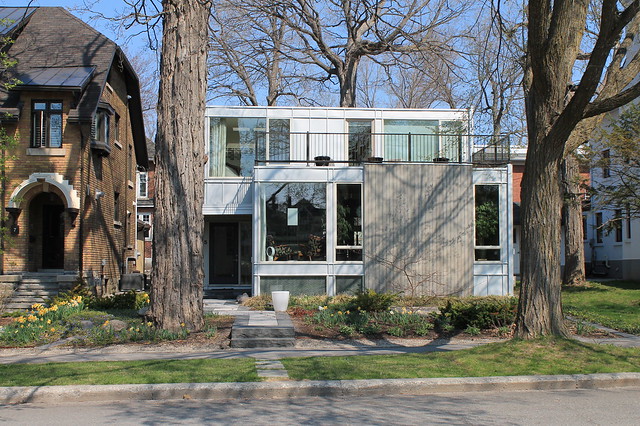JanesWalkOtt: Return to the Glebe
We will discuss the architectural history of the new Noffke Heritage District, the Sullivan Bridge and the public washrooms at Patterson Creek, as well as future development along the Driveway between Fourth and Fifth Avenues. We will also seek out some secret spots of the neighbourhood, especially the east end of Third Avenue, which has been documented by John Leaning in his book about the Glebe as a hotbed of eccentricity over the years.
Ah, Sunday morning walks through the Glebe! I spent much time in Central Park and along Patterson Creek during the years I lived in Ottawa. It was a little less pleasant having to bus from my friends’ home in Nepean in order to join up with my next Jane’s Walk—it took over a full hour. But it was nice to return to a familiar space and discover some unfamiliar stories about its past from our walk leader, John Walmsley.
 |
The walk started on Clemow, east of Bank in front of these two lovely homes by Ottawa architect W.E. Noffke. I told you we would see his name again. He was also the architect of Ogilvy’s department store from Padolsky’s Market walk. It’s not surprising that Noffke appeared in two separate Jane’s Walks. According to this Urbsite post, over 200 buildings in Ottawa have been attributed to Noffke. In 2012, the Central Park area was designated as the Clemow Estate East Heritage Conservation District, including 10 Noffke homes overlooking the park.
 |
We continued down Clemow as Walmsley continued to point out some of the other Noffke homes (shown in red on this map of the heritage conservation district). And then the shortest of stops to mention one home (marked in light pink “Categorie 4”). I don’t think many of the walk participants took much note of this home but it’s one of my favourites in Ottawa. This one is by yet another local architect, John Donkin. While looking it up for this post, I was surprised to learn it is a 2006 renovation. There’s something so beautifully mid-century modern about it that I guess I assumed it has been there for 40 years. But I guess that’s why I’d never noticed it until I moved back to the area in 2009. You can see a picture from before the renovation and some interior shots on Donkin’s website.
 |
 |
The walk continued along Linden for some more beautiful homes and peaceful street looking out onto Patterson Creek.
 |
 |
This is another great Ottawa space and I am always amused by the heritage public bathrooms. It’s a great precedent for Ottawa’s GottaGo campaign. You can see the same Spanish Colonial Revival influence from Noffke. The “pavilion” and the rest of the park was designed by the Ottawa Improvement Commission (precursor to the National Capital Commission). The park was meant to provide some natural beautification to offset the train tracks that once occupied the east side of the canal.
It’s also not an Ottawa Jane’s Walk if there is no mention of the NCC and Lansdowne. On the latter, the only mention was that there would be no talk of Lansdowne after a comment from the crowd. On the former, there was a refreshing change of perspective towards the NCC (and one I tend to align more closely with). This isn’t surprising given that John Leaning, former Chief Architect of the NCC was supposed to be one of our walk leaders though he was unfortunately able to join us. But Walmsley spoke with great respect and admiration for the NCC of the 1960s: “The great projects when they had great ideas and made it happen.”
 |
 |
We followed Queen Elizabeth for a while before turning down Third Ave for a stop infront of Leaning’s old house. I thought it was fascinating to see the tame vernacular character of the home of the NCC architect. It’s something I identify with. Professionally speaking, I keep finding myself caught between the intellectual and socialist lure of grand masterplans and projects on the one hand, and my work with traditional practices and underground communities on the other. Quoting from Leaning’s book on the Glebe, Walmsley said something about “ferrets, parrots, and pet pigs”. But the point being about diversity and tolerance (which maybe the Glebe is less an example of than it used to be) as the key to walkability.
 |
While I know there are many who wouldn’t agree, I think the string of apartment towers along the canal are quite appropriate and interesting. It’s very ‘democratic’ (though I hate that term). Maximize the number of people with canal views and access. The Glebe has a pretty bad reputation for being elite. I like to think of these towers as expressing a will of a certain era that wanted to see more people able to benefit from this great neighbourhood. This is what I mean about my big-project/for-the-people tendencies. And as Walmsley pointed out, the wind and shade they create provide a nice beneficial microclimate in the summer.
“You can always think of a tall building as your friend, sometimes.”
